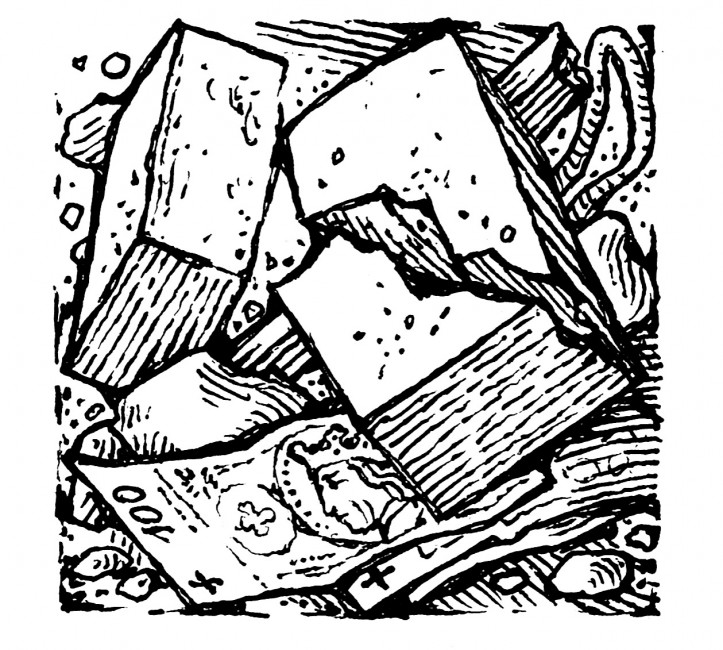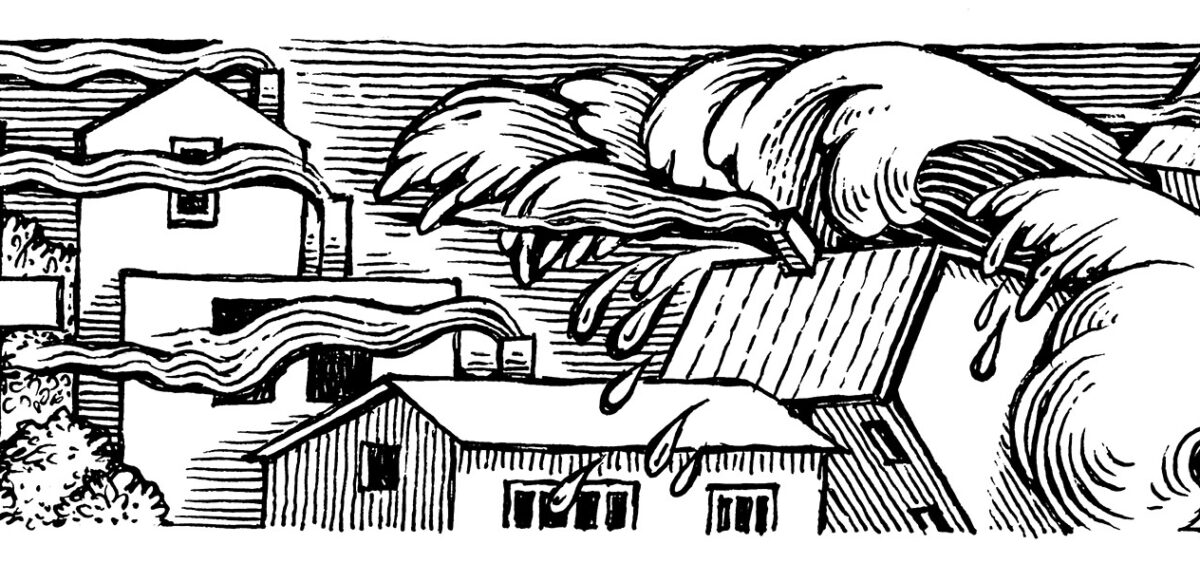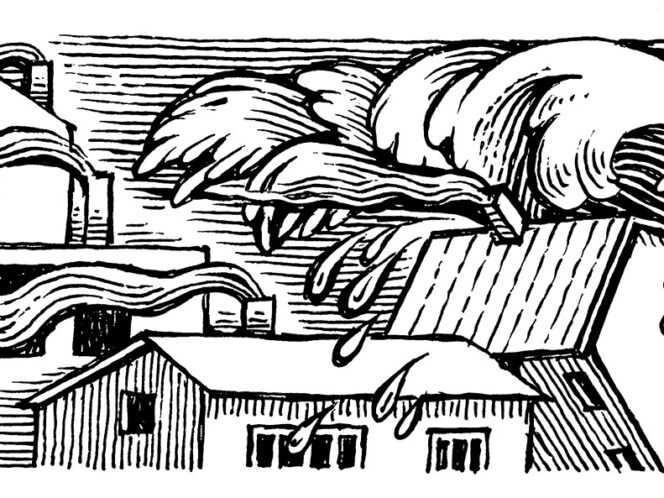
We have just experienced a small earthquake and we have less than an hour to flee to the mountains. The world as we know it, the brief era of the global domination of the West, is coming to a close. What was exceptional has now become a part of everyday life.
“Did you notice? There was an earthquake,” Tomoko inquired in passing, as I came down to the kitchen to do the washing up. “Yes,” I replied, although it wasn’t until she asked the question that I gained solid clarity as to what that brief imbalance of the world that occurred only an hour ago really meant. The tremor was so gentle and so short that I instinctively decided I was simply tired from the jet lag. My partner, who had lived in Tokyo before me, told me that her very first earthquake sounded like the scratching of mice in the closet. Meanwhile, it was the building that was creaking, or things that were shifting around in the drawers.
Minor earthquakes are a part of everyday life in Japan. Yet even the larger ones aren’t the problem. The problem are the tsunamis that are evoked by the more serious shakes. The feeling of the ground rolling under your feet is only a signal that quite soon (anywhere from 15 minutes to a few hours) a wave will come that will wipe away your entire world. But everything is under control for now. Nothing has happened yet. The buildings are standing, everything seems to look normal.
And that’s when we need to believe in the impossible: that the world around us will soon cease to exist. This knowledge, or basically belief, is one of the foundations of life in countries that experience the end of the world on a cyclical basis. And that’s why in the town of Kesennuma, which was wiped off the face of the Earth in 2011, you will find a cornerstone and on it the following inscription:
“Run! Run up to the mountains! Don’t worry about the others. Save yourself first. And tell the generations to come that the tsunami made it to this spot. And those who survived were the ones who ran. To the mountains. So run! Run to the mountains!”
The moment in which we know that the tsunami is coming is a very difficult one. Because you don’t have the time to pick up your kids from pre-school or go find your mother who happens to be running some errands at the shopping centre. You need to believe that they also know what you know and that they will start running up to the mountains, to defend themselves from the great wave that is inevitably approaching and that will wash away the entire world. You also need to believe that the institutions created to rescue the population in the situation of an approaching tsunami will work. That the pre-school teachers will take your child up into the mountains, while the shopping centre’s evacuation system will work without a hitch.
This is the very reason why Japanese society is so brilliantly organized. The symbol of this society is perfectly operating transport systems – when a train arrives at a platform, each passenger knows perfectly well where to stand to have the door of the train car right in front of them. Each Japanese home has a backpack containing the most essential first aid items. If it turns out that you need to run, you can take it with you. You can find an evacuation plan on every street corner. Everybody is quite aware of the fact that the end of the world can happen at any given moment.
Another piece of knowledge inherited from earlier generations is the fact that a big earthquake, the type that turns the entire world to dust, comes roughly once every 100 years. The last such quake occurred in Tokyo in 1924. Most of the city went down in flames then. Yet it was rebuilt very quickly. If you live in a world of cyclical earthquakes, you don’t build houses from stone, you use light materials. Because you know that they’ll disappear soon anyway. That’s why the houses in Tokyo are younger than its people; the average age of a Tokyo building is 26 years, while the average age of a Tokyo resident is 44.
Tokyo is a city undergoing constant change to make sure that everything can stay the same. Its continuity is not embedded in its physical fabric, like in the case of Western cities, but rather in the ownership structure. That’s why the Western mania of conservation and the consideration of nearly everything that is even lightly covered in patina as precious (even if it’s the impractical and hardly valuable urban cobblestone) is completely incomprehensible to the Japanese. When the city turns to dust, the only thing left is the topography, the small differences in height between each hill, or the shape of the valleys. The city is then rebuilt based on these subtle topographic differences. It seems to look different, as the buildings are newer and have a different shape. Yet land distribution and the ownership structure remain unchanged. The wealthy live a bit higher up, while the poor stay down below (this is because the hills, especially those on harder ground, are more resistant to earthquakes). That’s why the streets of modern-day Tokyo follow exactly the same course as they did in 18th-century Edo, sometimes connecting small hills or running through valleys. And the government buildings stand in the same place where the mansions of the Japanese magnates used to.
Throughout most of history, humanity had an approach to nature that was similar to what is still prevalent in Japan. Nature was a threat and that’s why it was reasonable to at least respect it, if not fear it. Peasants in Europe were often only one failed harvest away from dying of hunger. Children’s stories like Little Red Riding Hood, in which a child is eaten by a wolf, shouldn’t be read metaphorically but literally. For psychoanalysts such as Erich Fromm, Little Red Riding Hood was a symbol of virginity, while the wolf represented wild insatiable masculinity. He and many other contemporary intellectuals racked their brains in search of the real meaning behind this strange story. It never occurred to them that the story meant exactly what it was saying. When the story was first written in 17th-century Europe, children were working from the time they were little, usually grazing animals on meadows or in forests (such as pigs). These children would occasionally be attacked by wolves and die as a result. And the purpose of these stories was to warn them of a substantial danger.
So that’s exactly why, out of respect for nature, residential settlements in port cities were built at a safe distance from the sea. This was the case in Amsterdam, London, Stockholm, Hamburg and Lisbon. Today, on the other hand, coastlines are being developed, and prestigious and luxurious apartment buildings are quite often located right on the beach. It was indeed the Westerners who first decided that they did not need to reckon with nature. Cities founded as a part of the Anglo-Saxon colonial expansion, such as New York or Mumbai, had already been developed on the foundation of Western arrogance towards the powers of nature. It never occurred to their constructors that they needed to be protected from the sea.
When the first great wave appears, which will happen faster than we thought just a while ago, they will be the first to disappear into the waves of the oceans.
***
We live in a moment in which we have just experienced a small earthquake and have less than an hour to flee to the mountains.
That very moment of brief collapse came in 2008 when the pillars of the global finance system tumbled and it seemed that the world was teetering on the edge of an abyss. The head of the US Federal Reserve was trying to convince the top brass of the Democratic Party during a hastily organized meeting that the government had to bail out the banks from bankruptcy. “If we don’t do this tomorrow,” Ben Bernanke said on Thursday, “we won’t have an economy on Monday.” He probably didn’t know himself what that was supposed to mean, but nobody had enough courage to find out. So the Government pumped billions of dollars into the financial sector and bailed out Wall Street, so that everything could be like it used to.

Alan Greenspan, Bernanke’s predecessor, whose decisions directly led to the collapse, admitted after the fact that the events of 2008 left him in a state of “shocked disbelief”. Indeed, none of the mainstream economists had anticipated the catastrophe. Even at the beginning of 2008, leading newspapers would repeat the thesis that the world had entered an era of Great Stabilization, while Nobel Prize winner in Economics Robert Lucas stated that the “[…] central problem of depression-prevention has been solved, for all practical purposes, and has in fact been solved for many decades.” The American elites were convinced that the ‘end of history’ had arrived and that nothing would disrupt their global domination and economic prosperity.
Yet the collapse did come, and it is indeed the symptom of a fundamental fall-out: the twilight of the global domination of the US and the West.
Why was it such a surprise? The people who caused the meltdown were too young to remember the last serious collapse of the US economy, specifically the oil crisis of the early 1970s. They therefore sincerely believed that the American economy would continue to grow into oblivion and that the American ‘wonder years’ would never end. That tomorrow will be like today, because today is just like it was yesterday. That an event could suddenly change everything is highly unlikely.
Yet none of the older and more experienced experts disrupted that conviction either. Nobody conveyed to them the knowledge – which you can read off the rock in Kesennuma – that there will be a time when the end will come; that when you see the first warning signal, you need to leave everything and run. The Western world lives by the rule once described by John Steinbeck in East of Eden: “And it never failed that during the dry years the people forgot about the rich years, and during the wet years they lost all memory of the dry years. It was always that way.” That’s perhaps why the warnings put forth by economists from beyond the mainstream, such as Hyman Minsky, were ignored. From his studies on crises in Western economies, Minsky extracted the following credo: stabilization destabilizes. Always.
Once Wall Street was rescued, the Western elites adopted a ‘back to business as usual’ approach to the crisis. A number of serious conclusions were drawn from the Great Depression in 1929, and the backdrop of economic debate radically changed a decade later, once the greatest minds in the world had deliberated on how to prevent the outbreak of another crisis. Yet this – and the fact that the latest collapse has resulted in an economic breakdown that proved just as painful as the one from the 1930s – did not seem to spoil the good mood of even those who had caused it. Economists still speak the same language, and soon the memory of the last collapse will fade out to the point that the next recession will be welcomed with a sense of disbelief.
Meanwhile, reality abounds in ‘out-of-this-world’ events: Hurricane Sandy (according to statistical models used by climatologists, there was no way it could have veered in the direction of New York); the triumph of Donald Trump (whose candidacy had merely brought ironic smiles to the faces of publicists a year before the election); or the decision made by British voters to leave the European Union (an outcome that the polls did not foresee). All of this is hard to grasp, because prevailing not only in economic models, but also in common awareness, is a linear approach to time; the assumption that the future is a regular continuation of the present. Meanwhile – much like boiling water turns to steam at a certain point – the physical state of the modern world has inconspicuously undergone a fundamental transformation.
Western culture has abandoned the language that would allow us to discuss the matter, as Amitav Ghosh argues in his 2016 book The Great Derangement: Climate Change and the Unthinkable. Science as well as literature have been created to describe all that is probable, average and foreseeable. While scientists in the 16th century were still engaged in phenomena like human giants or raining frogs, later on all that was unusual was expelled beyond the horizon of scientific learning. When stories were told before the birth of the modern novel, they would be about things that were unlikely, like in Gargantua and Pantagruel. The Flaubertian novel, which emerged along with the birth of statistics, suppressed all that was improbable and focused on things that were common, day-to-day and average. Both approaches to knowledge have one thing in common: gradualism, or the conviction that change is linear and does not occur incrementally, and that the future can be foreseen by observing the past. The exceptions only prove the rule, because the purpose of learning is to describe that which is average. That’s why in a Western novel we do not encounter any sudden plot twists caused by a tornado, flood or earthquake. Such an intervention is considered to be an amateurish narrative trick, which has no place in ‘proper’ literature.
Meanwhile, what was exceptional has now become a part of everyday life.
Western culture is aware of this only on an intuitive level. If something unusual happens to us in our lives, we say: if that were to happen in a novel, nobody would have believed it! A similar diagnosis stands behind the volcano of emotion that has erupted in the public space over the past decade. We can perceive the so-called post-truth as a cynical intervention of certain governments, and that is certainly partially true. But it does not explain the especially fertile ground on which untrue and sensational news has fallen. We are observing a common erosion in our trust towards science, the blossoming career of so-called alternative medicine, and so on. The intuitive diagnosis hiding behind these phenomena is quite valid; indeed, the modernistic novel and science based on the analysis of probability are no longer able to effectively foresee the future. And it isn’t because they were false, but rather that they were created as a way to analyse a world that was fundamentally stable. While the world that we are living in now has imperceptibly slipped out of its well-known ruts and is now racing in a different direction.
Yet, as with any intuition, such a diagnosis will not get us very far. The tsunami stone in Kesennuma helps people to cope with the moment of the end of the world, but Western culture is powerless here. The high temperature of present-day public debate only signals the uncommonness of our times, but it does not allow us to confront it. In Great Britain, the key topic for the past three years has been the attempt to square the circle called Brexit and the turmoil inside the Conservative Party. The entire world gets all excited with one absurd tweet by Donald Trump. In Poland, the media is seriously debating whether Lech Kaczyński drank vodka in Magdalenka (where pre-round table discussions between Communist Party authorities and Solidarity union representatives took place in 1989) or not.
This is the storm before the calm that is absorbing most of our attention nowadays, although the real issue is somewhere else. We get excited by things we shouldn’t be excited about. In Western culture, we’ve grown to believe that the weather is the most boring of all topics; we can use it to fill moments of awkward silence, when we have nothing to talk about. Yet our emotions are elicited by different matters – sex, sports or money – while it is indeed climate change that should be the number one topic. The world has swayed for a moment and we don’t have much time to make a run for the mountains. If we don’t understand that, our chances of survival will radically drop.
***
How did it happen that Western people have managed to suppress the knowledge that lean years are followed by years of plenty, while years of prosperity are followed by times of drought? Have they believed in their own uniqueness and the fact that they are above nature? That they are able to protect the world from that which is imminent?
Perhaps this is the deepest myth of the West – the myth of the lone hero, the superhuman who saves the world with resourcefulness, wit, will power and persistence. Every other American film, from Indiana Jones to Batman, touches on this phenomenon.
Like all superstitions, this myth is partially based on facts. Above all, throughout much of history, the West has been exceptional, only not in a positive sense, but rather a negative one. As, for example, Jack Goody shows in his book The Theft of History, the belief that the Renaissance constituted an exceptional era in human history, a period during which humanism, art, medicine, science and so on were discovered for the first time, stems from the parochialism of the far West. From our point of view, the Renaissance or revival is the moment when the dreadful era referred to as the Middle Ages ended. Yet the Middle Ages were a period of civilizational collapse only in the West; this is because the West was cut off from the rest of Eurasia and experienced isolation from wealthier regions, due mainly to the expansion of the Muslim world. So what the West refers to as the revival was actually the moment at which the West started to catch up with everybody else.
In school, we learn that Italian painters invented perspective. Nothing could be further from the truth; they copied solutions that were the creation of Ibn al-Haytham, an Arab mathematician in the 11th century (as shown by Hans Belting in his book Florence and Baghdad). After all, we know that Europeans ‘discovered’ the Greek classics thanks to Arab thinkers. The first industrial revolution took place not in England, but in mediaeval China. It was also there that banknotes were first used on a mass scale, while at the same time in Europe a non-monetary economy prevailed. Basically, most civilizational advances were created outside of the Western world. In his book, The Eastern Origins of Western Civilisation, John Hobson is quite merciless: “The only genuine innovations that they [Europeans] made before the eighteenth century were the Archimedean screw, the crankshaft or camshaft and alcoholic distillation processes.”
The 20th century dispute as to why the West outdistanced the East was focused on the search for a specific characteristic of Western culture, which would predestine it for global domination. Exceptional skills and inventions were described that changed the fate of the world (such as the promissory note, although the Italians ‘borrowed’ that from the Arabs as well), or cultural traits, such as thriftiness and diligence. Today there is a scientific consensus as to the fact that in 1800 the West not only had no advantage over the East, but also nothing seemed to have indicated its later domination. Yet this period was shorter than we may think: it wasn’t until 1870 that the combined economies of Great Britain and the US overtook India or China (I analyse this in detail in my book Kapitalizm. Historia krótkiego trwania – Capitalism: A History of Short Continuance).
They got ahead because the Anglo-Saxon West succeeded at something new: finding the key to maintaining economic growth. Before this, any economy that started to dynamically grow, be it the Muslim world in the early Middle Ages, or the Chinese economy in the 13th century, always encountered an ecology-related obstacle. When the basic fuel was wood, any small industrial revolution would end dramatically with radical deforestation, which nobody could do anything about. The quantity of available wood depends on the available territory. And in the end, it does have its limits. That’s why any proto-industrialization effort would ultimately hit the wall of ecology and collapse.
The secret to Western success was the use of fossil fuels for growth. Coal differs from wood in that it is independent of territory; coal deposits seemed to be unlimited, and were also more compressed. As a result, the place of energy production and the place of energy consumption were separated (which was also the advantage of steam engines over hydro-powered machines, since with the latter factories had to be located near rivers). Therefore, it gave the possibility to ‘detach’ from the powers of nature: water, wind, bad weather, location. A civilization built on fossil fuels indeed negates the principles that had governed the world earlier on. But as Kenneth Pomeranz argues in The Great Divergence, it was actually the geographical luck of the parvenus that made the difference: Great Britain was rich in coal, and, in addition, the deposits were close to the cities. Coal had been known in China for a long time and was even used, but rather in homes for cooking or heating, and not in industry. But the side effects of such practices quickly appeared in the form of pollution. And that was in all probability the main reason for which the Chinese did not opt for the use of coal to develop industry in the 19th century.
England had one more resource by chance: the vast spaces of North America that could be colonized. What’s more, America was conquered not because of the superhuman traits of the West, but mainly because the indigenous peoples died from all the plagues that the Europeans brought over with them and to which these newcomers happened to be immune. The vast American territory allowed for the expansion of agriculture, which would continue to supply the raw materials needed for growth: food for the cities, and cotton, which British factories would then process into the textiles that built the base of British growth. Then came the second industrial revolution, or the moment at which electricity, cheap steel, the chemical industry and yet another fossil fuel – crude oil – appeared. That’s when the foundation of the modern world was created, a metropolitan civilization and its key symbol, the automobile – this is how we live to this day. This civilization attained a global scale, and the leadership baton passed from Great Britain to the US and Germany.

The basic rule of the 150 years of Western domination was the idea of growth, or the concept that tomorrow should be slightly better than today; that there should be just a bit more of everything. Economists believe that a ‘healthy’ economy develops at a rate of 3% annually. That doesn’t seem like a lot, but this growth accumulates; in the following year, the 3% is calculated from the 103% in the previous year, and so on. In the scale of a generation, or 30 years, that’s a veritable revolution: 143%. If this 3% is an expression of a new technology, new product or new service, then each generation lives in a completely different reality. That’s how it’s been for the past 150 years, when parents were not able to keep up with how their children lived. The conflict between generations was actually a result of the fact that parents and children did indeed live in different worlds.
Why is it that 3%, and not 5% or 2% became one of the ironclad rules of Western capitalism? Again, based on individual experience, a universal law was coined: quite simply, the actual rate of GDP growth is on average at the same level it’s been at for the last 150 years. However, we cannot maintain this growth: 3% annually on each złoty or Euro is not much, but 3% annually on one billion złotys or Euros is a lot. When capitalism was limited to a few British factories and their raw material supply base, a growth rate like that was quite feasible. Since today the entire world is entangled in capitalism, it’s increasingly difficult to produce more and more. That’s exactly why economic growth is becoming progressively ‘virtualized’ among other things; from the point of view of GDP, it doesn’t matter if a physical good or real service was created, all that matters is the moment at which money changed hands. So to keep the growth rate at a ‘healthy’ level, Western economies placed their bets on the development of the financial sector. This growth is all but completely virtual, though moments of its collapse, such as that in 2008, produce real consequences for millions of people.
***
How will this all end? As it usually does: ecologically. Although in line with the myth of the West, the rise and fall of civilizations are always associated with internal cultural traits (the first, with resourcefulness, cunning, creativity and so on; while the second, with conceit, self-righteousness and inattention), recent research shows that before the fossil fuel era, good and bad periods appeared in every corner of the world at about the same time. It is indeed the ecological situation, as Victor Lieberman shows in his book, Strange Parallels that explains why fully autonomous countries and civilizations developed simultaneously. It is ecology that intertwines the destinies of France, Russia, Vietnam and China. In Europe, we live by the myth of the Roman Empire, although on the other end of Eurasia, the equally powerful Han dynasty appeared in China, and it is to this day reminisced as the golden age in Chinese history and the first time when the Chinese state became one.
As Kyle Harper shows us in his book, The Fate of Rome, standing behind Roman prosperity was first and foremost the warm climate. Thanks to increasing temperatures (associated with the change of the angle of Earth’s axial tilt as it orbits the Sun), grain could be cultivated even in the mountains. “If we only count the marginal land rendered susceptible to arable farming in Italy by higher temperatures,” Harper writes, “on the most conservative estimates, it could account for more than all the growth achieved between Augustus and Marcus Aurelius. In such perspective, human toil can seem vain. The hard fatalism of the farmer is made of such stuff. The supreme sway of the climate is nothing if not humbling.” The time when the climate started to cool down, between 530 and 540 AD (due to the eruption of volcanoes), is when the fall of the Roman Empire began.
Of course, emotional turbulence appears during every end of the world, and attempts are made to explain events through human action or neglect and to place blame on somebody. Yet the brutal truth is that for ages, the boundary conditions of human activity have always been defined by nature. And that’s the way it will be this time around as well, although the end of our world will differ from the previous ones by the fact that we ourselves will be its cause.
Translated from the Polish by Mark Ordon







